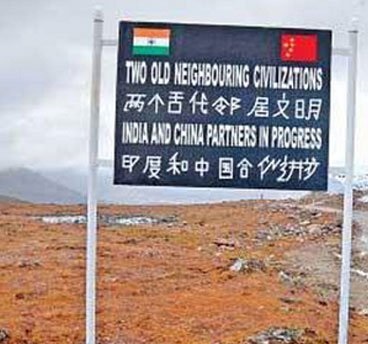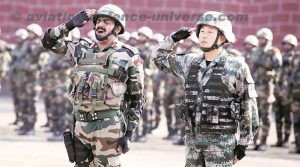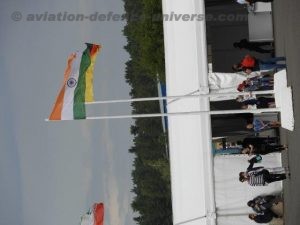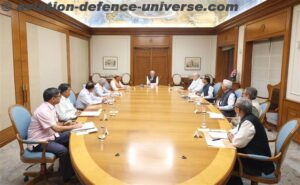
By Sangeeta Saxena
New Delhi. 06 June 2020. As the day dawns all eyes are on the northern front where Indian Army’s Corps Commander of the XIV Corps stationed in Leh will meet the chief of China’s Southern Xinjiang Military District at the Chushul-Maldo Meeting Point. Hope GOC XIV Corps Lt Gen Harinder Singh and China’s Tibet Military District Commander Lt General Xu Yong are able to reach a ‘mutually acceptable temporary resolution’. For an officer who has been both DGMI and DGMO of the Indian Army, it definitely is not an insurmountable challenge.
And just prior this powerful military meeting a diplomatic step was taken by the two nations, when Indian Ministry of External Affairs Joint Secretary (East Asia) Naveen Srivastava and Wu Jianghao Director General in Chinese Ministry of Foreign Affairs held a meeting via video conferencing. The two sides reviewed the state of bilateral relations including the current developments.
In this context they recalled the consensus reached by the leaders of the two countries, that peaceful, stable and balanced relations between India and China will be a positive factor for stability in the current global situation. Both sides also agreed that in accordance with the guidance provided by the leadership, the two sides should handle their differences through peaceful discussion bearing in mind the importance of respecting each other’s sensitivities, concerns and aspirations and not allow them to become disputes.
Whereas Geng Shuang, the spokesperson of the Chinese Ministry of Foreign Affairs in his last press conference before leaving for the next assignment stated, “ at present, the overall situation in the China-India border areas is stable and controllable. There are sound mechanisms for border-related matters between China and India. The two sides maintain close communication through diplomatic and military channels and are working to properly resolve relevant issues.”
China knows for sure that India of 2020 is not India of 1962 and also understands that the Indian Army is prepared to stand up to any instigation at the LAC. And the most important factor is that China also knows that its soldiers who started the border skirmishes on May 5 at the Galwan valley in Ladakh and then at Nakula pass in northeastern Sikkim region three days later which resulted into the stand-off along the Line of Actual Control, have a strong , dedicated and never say die Indian soldiers to combat with. Diplomatically China has not made a single statement where it implies on a military solution to its created crisis.
Another Chinese Spokesperson Zhao Lijian in the routine press interaction stated, “ China’s position on the boundary issue is consistent and clear. We have been earnestly implementing the important consensus reached by the leaders of the two countries, strictly abiding by the relevant agreements signed by the two countries, and committed to safeguarding China’s territorial sovereignty and security as well as peace and stability in the China-India border areas. At present, the overall situation in the China-India border areas is stable and controllable. On border-related issues, there have been sound mechanisms and channels of communication between China and India, and the two sides are capable of properly resolving relevant issues through dialogue and consultation. There is no need for any third party to intervene.”
Indian Defence Minister in an interview to a television channel had said, “”I want to assure the country that we will not allow India’s pride to be hurt under any circumstances. India has been following a clear policy of maintaining good relationship with neighbouring countries and it is not a new approach. We have been following it for long. At times, situation arises with China. It has happened before.”
China’s official response to this when asked in its press conference given by Spokesperson Zhao Lijian is, “ On border-related issues, China has been implementing the important consensus reached by the two presidents, strictly observing bilateral agreements, and committed to safeguarding territorial sovereignty and security as well as peace and stability in the China-India border area. Currently the overall situation along the border is stable and controllable. Between China and India, there are unimpeded channels for border-related communication in diplomatic and military fields. We believe the issues can be properly resolved after bilateral negotiations and consultations.”
A clear difference in China’s diplomatic talk and military action is visible. If it wants diplomacy to win then it has to stop getting worried about India’s infrastructure development in areas on Indian side of LAC. The right to develop infrastructure does not belong only to them. Developmental projects for regions which need them and for making movement easier and less time taking for travellers need to be taken with logic and not with a pinch of salt always. Can China afford a military adventure with India in the current scenario when India’s goodwill globally is strong and China’s at its lowest ebb? China knows for sure it cannot but does not refrain from getting its big brother attitude better of its common sense. De-escalation of the current tension at LAC is the need for China more than India, today. And China is intelligent enough to understand this.
In five hours from now the meeting between the top military commanders should be able to put an end to this standoff between the two armies and ease both military and diplomatic tensions. So just keeping our fingers crossed and waiting for the news of the success of the talks to come in.

































































































































